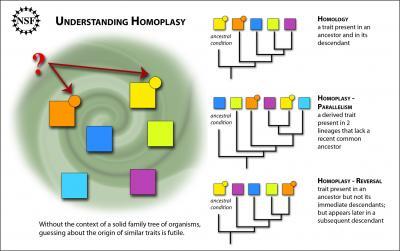With the genetics of so many organisms that have different traits yet to study, and with the techniques for gathering full sets of genetic information from organisms rapidly evolving, the "forest" of evolution can be easily lost to the "trees" of each individual case and detail.
A review paper published this week in Science by David Wake, Marvalee Wake and Chelsea Specht, all currently National Science Foundation grantees, suggests that studying examples of homoplasy can help scientists analyze the overwhelming deluge of genetic data and information that is currently being generated.
For example, studying situations where a derived trait surfaces in two lineages that lack a recent common ancestor, or situations where an ancestral trait was lost but then reappeared many generations later, may help scientists identify the processes and mechanisms of evolution.

Homoplasy is a fascinating and unusual occurrence in evolution. It is the independent acquisition of the same trait in unrelated lineages. To understand whether multiple organisms share the same trait because of homoplasy, their places in the evolutionary tree of life must be defined.
Parallelism/convergence homoplasy occurs when the same trait is present in two lineages that lack a recent common ancestor. Reversal homoplasy occurs when a trait is present in an ancestor but not its immediate descendants; but appears later in a subsequent descendant.
(Photo Credit: Zina Deretsky)
The authors provide many fascinating examples of homoplasy, including different species of salamanders that independently, through evolution, increased their body-length by increasing the lengths of individual vertebrae. By contrast, most species grow longer by adding vertebrae through evolution.
The authors also explain how petals in flowers have evolved on six separate occasions in different plants. A particularly striking example of homoplasy cited by the authors is the evolution of eyes, which evolved many times in different groups of organisms--from invertebrates to mammals--all of which share an identical genetic code for their eyes.
These kinds of examples of genetic and developmental biology help scientists elucidate relationships between organisms, as well as develop a fuller picture of their evolutionary history.
Source: National Science Foundation